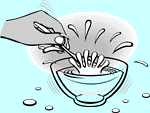|

Why does my Ooze act like that?
Your Ooze is made up of tiny, solid particles of cornstarch
suspended in water. Chemists call this type of mixture a
colloid
.
As you found out when you experimented with your Ooze,
this colloid behaves strangely. When you bang on it with a spoon or quickly
squeeze a handful of Ooze, it freezes in place, acting like a solid. The
harder you push, the thicker the Ooze becomes. But when you open your hand
and let your Ooze ooze, it drips like a liquid. Try to stir the Ooze quickly
with a finger, and it will resist your movement. Stir it slowly, and it
will flow around your finger easily.

Smack water with a spoon and it splashes.
Smack Ooze with a spoon and it acts like a solid.

Most liquids don't act like that. If you stir a cup of
water with your finger, the water moves out of the way easily--and it doesn't
matter whether you stir it quickly or slowly.
|
Your finger is applying what a physicist would call a
sideways
shearing force
to the water.
In response,
the water
shears
, or moves out of the way. The behavior of Ooze relates
to its
viscosity
, or resistance to flow. Water's viscosity doesn't
change when you apply a shearing force--but the viscosity of your Ooze does.
Back in the 1700s, Isaac Newton identified the properties
of an ideal liquid. Water and other liquids that have the properties that
Newton identifies are call
Newtonian fluids.
Your Ooze doesn't act
like Newton's ideal fluid. It's a
non-Newtonian fluid
.
There are many non-Newtonian fluids around. They don't
all behave like your Ooze, but each one is weird in its own way. Ketchup,
for example, is a non-Newtonian fluid. (The scientific term for this type
of non-Newtonian fluid is
thixotropic
.
That comes from the
Greek words
thixis
, which means "the act of handling" and
trope
, meaning "change".)
Quicksand is a non-Newtonian fluid that acts more like
your Ooze--it gets more viscous when you apply a shearing force. If you
ever find yourself sinking in a pool of quicksand (or a vat of cornstarch
and water), try swimming toward the shore very slowly. The slower you move,
the less the quicksand or cornstarch will resist your movement.
|